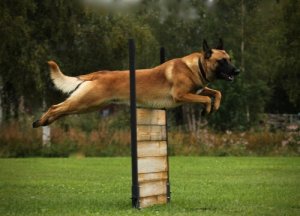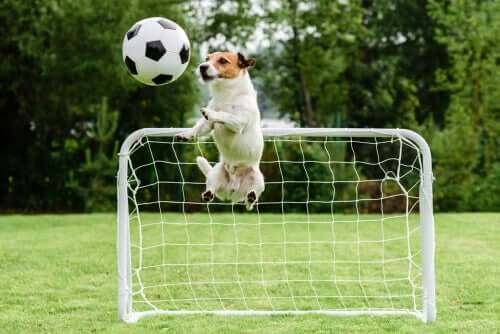The Importance of Exercise for Dogs


Written and verified by biochemistry Luz Eduviges Thomas-Romero
Exercise for dogs is as important as it is in humans and we all know we should stay as active as we can to maintain both our physical and mental well-being.
Dogs can release stress through physical activity, and, along with a balanced diet, it determines their quality of life. So, you must provide your pet with their basic health requirements. Today we’ll discuss why it’s important to ensure that your dog is getting a daily cardiovascular routine.
Exercise for dogs is key to fighting anxiety
Exercise is a proven way to decrease anxiety in dogs. All guardians are in charge of their pet’s good physical shape. Believe it or not, this simple measure could save you the shock of coming home and finding your couch torn apart.
A lack of exercise and mental stimulation will starve a dog’s need for attention and they’ll get it through destructive behavior.
The more activity, the less aging
Undoubtedly, getting the right amount of exercise can help maintain mental agility in dogs, just as in humans. This results in a lower incidence of age-related diseases.
Of course, exercise must be tailored to your pet’s age and level of fitness. Keep in mind that, while it’s important for older dogs to stay active, they shouldn’t overdo it. For that reason, we strongly recommend that you get advice from your vet on how much and what type of exercise is most appropriate for your specific dog.

Exercise in dogs prevents osteoarthritis
Regular exercise is one of the best ways to maintain the good health of your pet’s joints. Keep in mind it’s not just about maintaining proper weight to avoid excess pressure on them. Exercise also keeps them lubricated while strengthening their supporting muscles.
Those who exercise together stay together
No doubt the emotional bond strengthens when dogs and their guardians exercise together. This is because exercise is a stimulating activity and sharing it is a form of positive reinforcement for your friendship. Even a simple routine like walking every day will improve your dog’s mental and cardiovascular balance.
Of course, you should always put yourself in your pet’s paws. For example, consider that seashells might hurt a dog’s sensitive paws when they run around at the beach. In addition, exercising in the sunshine can also lead to heatstroke.
Every dog needs a job
Humans first selected dogs for specific jobs. Thus, your friend’s ancestor was either bred for hunting or grazing or for some other purpose. For this reason, you must let them follow their instincts to some extent.
It isn’t about taking them hunting, but about providing them with interesting opportunities to do things according to their needs. If a dog doesn’t have a job that’s appropriate to their age and breed, chasing a Frisbee, for example, then they’ll find one that you may not like! It might be barking excessively at passers-by or going through the trash.

Exercise leads to obedience in dogs
Who’s a good boy? One who had a chance to exercise. If you want your puppy to obey you more enthusiastically, then you must find opportunities to actively interact with them. When you spend time playing with them and teaching them new games, then your relationship becomes stronger and they listen to you more intently.
Open the way to proper socialization
Exercise can, and should, be part of a routine of exposure to other dogs, people and environmental stimuli. This is a very effective way to get a young dog on the right track to socialization.
Note that a leisurely walk around the block simply won’t meet the needs of most dogs. However, lively play in the park with other dogs promotes their socialization. And it also ensures that younger dogs get the appropriate level of effort.
Exercise for dogs is as important as it is in humans and we all know we should stay as active as we can to maintain both our physical and mental well-being.
Dogs can release stress through physical activity, and, along with a balanced diet, it determines their quality of life. So, you must provide your pet with their basic health requirements. Today we’ll discuss why it’s important to ensure that your dog is getting a daily cardiovascular routine.
Exercise for dogs is key to fighting anxiety
Exercise is a proven way to decrease anxiety in dogs. All guardians are in charge of their pet’s good physical shape. Believe it or not, this simple measure could save you the shock of coming home and finding your couch torn apart.
A lack of exercise and mental stimulation will starve a dog’s need for attention and they’ll get it through destructive behavior.
The more activity, the less aging
Undoubtedly, getting the right amount of exercise can help maintain mental agility in dogs, just as in humans. This results in a lower incidence of age-related diseases.
Of course, exercise must be tailored to your pet’s age and level of fitness. Keep in mind that, while it’s important for older dogs to stay active, they shouldn’t overdo it. For that reason, we strongly recommend that you get advice from your vet on how much and what type of exercise is most appropriate for your specific dog.

Exercise in dogs prevents osteoarthritis
Regular exercise is one of the best ways to maintain the good health of your pet’s joints. Keep in mind it’s not just about maintaining proper weight to avoid excess pressure on them. Exercise also keeps them lubricated while strengthening their supporting muscles.
Those who exercise together stay together
No doubt the emotional bond strengthens when dogs and their guardians exercise together. This is because exercise is a stimulating activity and sharing it is a form of positive reinforcement for your friendship. Even a simple routine like walking every day will improve your dog’s mental and cardiovascular balance.
Of course, you should always put yourself in your pet’s paws. For example, consider that seashells might hurt a dog’s sensitive paws when they run around at the beach. In addition, exercising in the sunshine can also lead to heatstroke.
Every dog needs a job
Humans first selected dogs for specific jobs. Thus, your friend’s ancestor was either bred for hunting or grazing or for some other purpose. For this reason, you must let them follow their instincts to some extent.
It isn’t about taking them hunting, but about providing them with interesting opportunities to do things according to their needs. If a dog doesn’t have a job that’s appropriate to their age and breed, chasing a Frisbee, for example, then they’ll find one that you may not like! It might be barking excessively at passers-by or going through the trash.

Exercise leads to obedience in dogs
Who’s a good boy? One who had a chance to exercise. If you want your puppy to obey you more enthusiastically, then you must find opportunities to actively interact with them. When you spend time playing with them and teaching them new games, then your relationship becomes stronger and they listen to you more intently.
Open the way to proper socialization
Exercise can, and should, be part of a routine of exposure to other dogs, people and environmental stimuli. This is a very effective way to get a young dog on the right track to socialization.
Note that a leisurely walk around the block simply won’t meet the needs of most dogs. However, lively play in the park with other dogs promotes their socialization. And it also ensures that younger dogs get the appropriate level of effort.
All cited sources were thoroughly reviewed by our team to ensure their quality, reliability, currency, and validity. The bibliography of this article was considered reliable and of academic or scientific accuracy.
- Hodgson, S. (2010). Dog Tricks and Agility For Dummies. John Wiley & Sons.
- Farber, S. D. (2002). Sports Medicine for Dogs Part 1: Prevention of Injury.
This text is provided for informational purposes only and does not replace consultation with a professional. If in doubt, consult your specialist.








